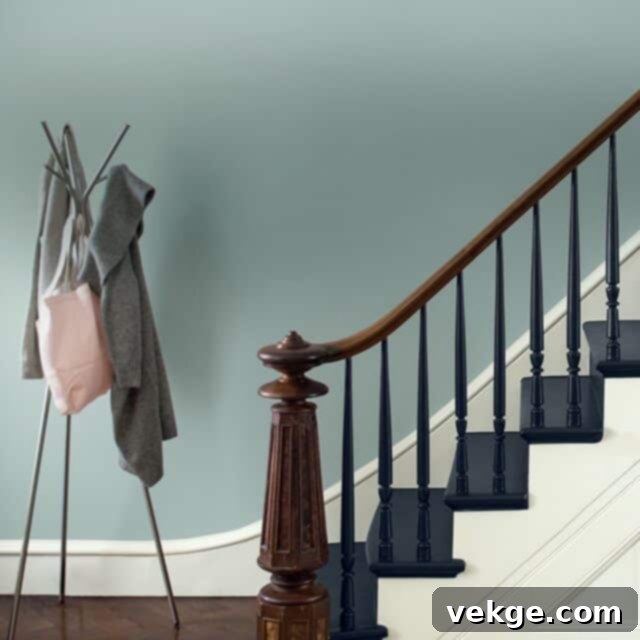Elevate Your Home’s Style: Discover the Best Staircase Color Combinations for Stunning Decor
The staircase is often a home’s architectural centerpiece, a prominent feature connecting multiple levels and guiding the eye upwards. More than just a functional element, its decor and color palette profoundly impact the overall aesthetic and flow of adjacent rooms. When planning a staircase decor makeover or simply looking to refresh its style, choosing the right hues is paramount. The colors you select for your staircase—from the treads and risers to the railings and surrounding walls—must harmonize with your home’s existing decor, furniture, and overarching theme. A cohesive color scheme ensures that this vital area contributes positively to your interior design, creating a seamless transition between spaces rather than a disjointed element. Certain colors and combinations naturally lend themselves better to staircase walls, railings, risers, and treads, influencing everything from perceived light and space to mood and sophistication.
Understanding the impact of color on your staircase design can unlock incredible potential, transforming a simple passage into a captivating focal point. Whether you aim for an airy, open feel, a dramatic statement, or a warm, inviting ascent, the right color choices are key. Here, we explore the best color combinations for your staircase, offering inspiration and practical tips to help you achieve the exact look you envision for your home.
1. All-White for Airy, Light-Filled Spaces
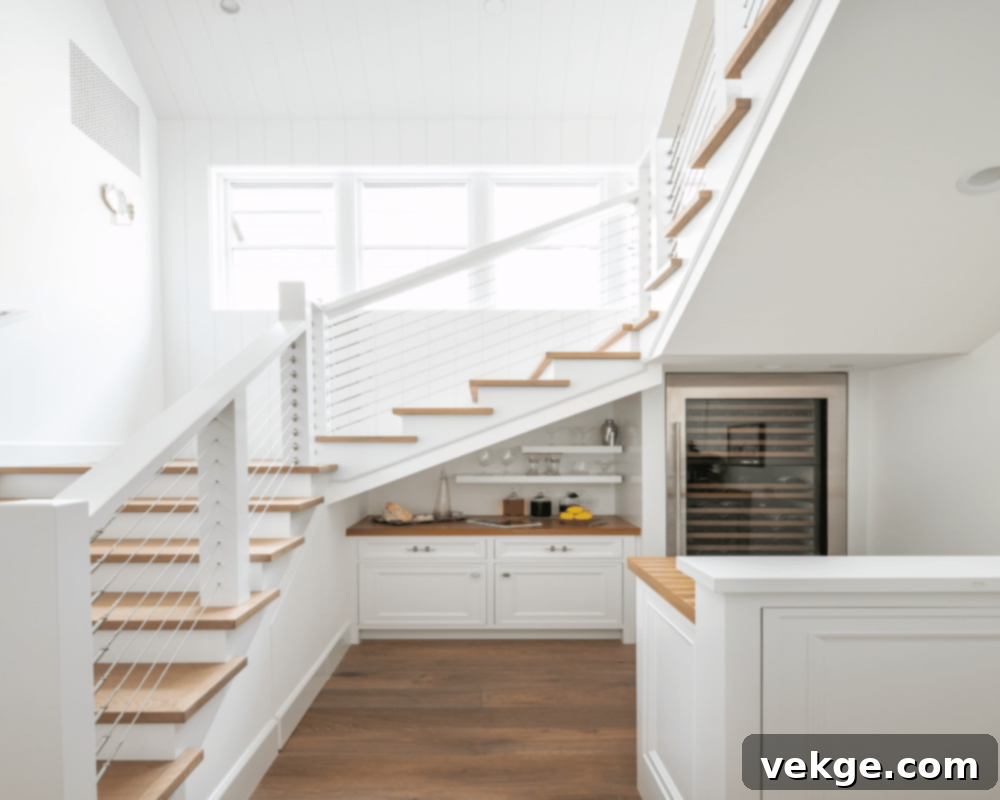
An all-white staircase is a timeless choice that instantly creates a light, airy, and expansive feel, making it perfect for contemporary, minimalist, Scandinavian, or coastal-inspired homes. White railings, treads, risers, and the surrounding walls work in harmony to keep the entire space bright, open, and inviting. This crisp, clean look not only enhances the sense of space but also allows other decor details to stand out, such as modern metal accents, intricate light fixtures, or geometric patterns in an adjacent area.
To add subtle depth and visual interest without sacrificing the monochromatic palette, consider using white paint with varying gloss levels. For example, a matte white on the walls can contrast beautifully with a semi-gloss or high-gloss finish on the railings and risers, creating texture and reflection. Alternatively, combining warm white walls with cooler white stairs and railings can introduce a nuanced layering effect. When decorating an all-white staircase, keep it simple: black and white abstract art, natural wood elements, or strategically placed greenery can provide a relaxing, oasis-like ambiance. While stunning, it’s worth noting that an all-white staircase requires regular cleaning to maintain its pristine appearance, especially in high-traffic areas.
2. Black and White for Dramatic Contrast

For a bold and sophisticated statement, the classic black and white combination is unparalleled. This high-contrast palette creates an eye-catching staircase that exudes timeless elegance and modern drama. There are several ways to implement this striking duo: you might opt for crisp black treads paired with pristine white risers, or reverse the scheme for a slightly different visual impact. Painting railings and banisters a glossy black, while keeping the walls and ceilings a bright white, maximizes this dramatic contrast, drawing attention to the architectural lines of the staircase.
To introduce a softer element or a three-tone look, consider adding a sophisticated gray stain or paint color on stair stringers or as an accent wall. The bold black-and-white palette is exceptionally versatile, perfectly suiting contemporary, modern, art deco, and transitional spaces. When working with such a powerful color scheme, it’s best to keep surrounding decor minimal. This allows the staircase itself to be the primary focal point, complemented by subtle metallic accents, geometric patterns in a rug, or a striking piece of wall art that echoes the monochrome theme. The enduring appeal of black and white ensures your staircase will always feel chic and current.
3. Wood Tones for Organic Warmth

The timeless appeal of wood tones brings unparalleled warmth, organic texture, and natural beauty to any staircase. Whether your home features rustic charm or refined elegance, wood stains offer a versatile solution. For a cohesive look that seamlessly integrates with your home’s existing aesthetic, select a wood finish that matches your hardwood floors. A rich gel stain in espresso or walnut, for instance, beautifully enriches the wood grain of treads and handrails, tying the staircase to wooded furnishings and accents throughout your living space. Alternatively, lighter stains like natural oak or maple can brighten a space while still imparting organic warmth.
For styles such as farmhouse, cottage, or rural interior motifs, soft gray wood stains or distressed, weathered finishes inject a charming, lived-in character. These finishes pair wonderfully with exposed brick or shiplap walls. For a multi-tone or contrasting look, consider pairing richly stained treads with painted white risers and neutral walls. This classic combination highlights the beauty of the wood while adding a touch of crispness. Incorporating wood into your staircase design not only enhances its visual appeal but also adds a durable and long-lasting element that speaks to quality craftsmanship. Complement this look with natural fibers, earthy tones, and lush indoor plants to amplify its organic appeal.
4. Rich Hues for Drama and Elegance

Deep, saturated colors possess the power to transform a utilitarian staircase into a bold design statement, imbuing it with unparalleled drama and elegance. Regal hues like emerald green, sapphire blue, ruby red, or deep burgundy can infuse a sense of luxury and sophistication into your home. Navy blue offers a striking and versatile alternative to basic black, providing depth without feeling overly heavy. These rich colors work exceptionally well in glamorous, classical, and traditional decor schemes, or even in eclectic settings seeking a touch of opulence.
To create a focal point, consider painting an accent wall alongside the staircase, or applying one of these saturated colors to the stair risers or even the treads themselves, then pairing them with white railings and neutral walls. This contrast prevents the dark hues from feeling too overwhelming and allows them to truly pop. For an even more luxurious effect, pair a rich wood stain on the treads with a jewel-toned painted riser, creating a striking visual contrast. Crisp white trim and architectural details will further define the space and highlight the richness of your chosen color. Don’t be afraid to experiment with plush runners or velvet accents to complete this opulent look.
5. Soothing Neutrals for Flexible Style
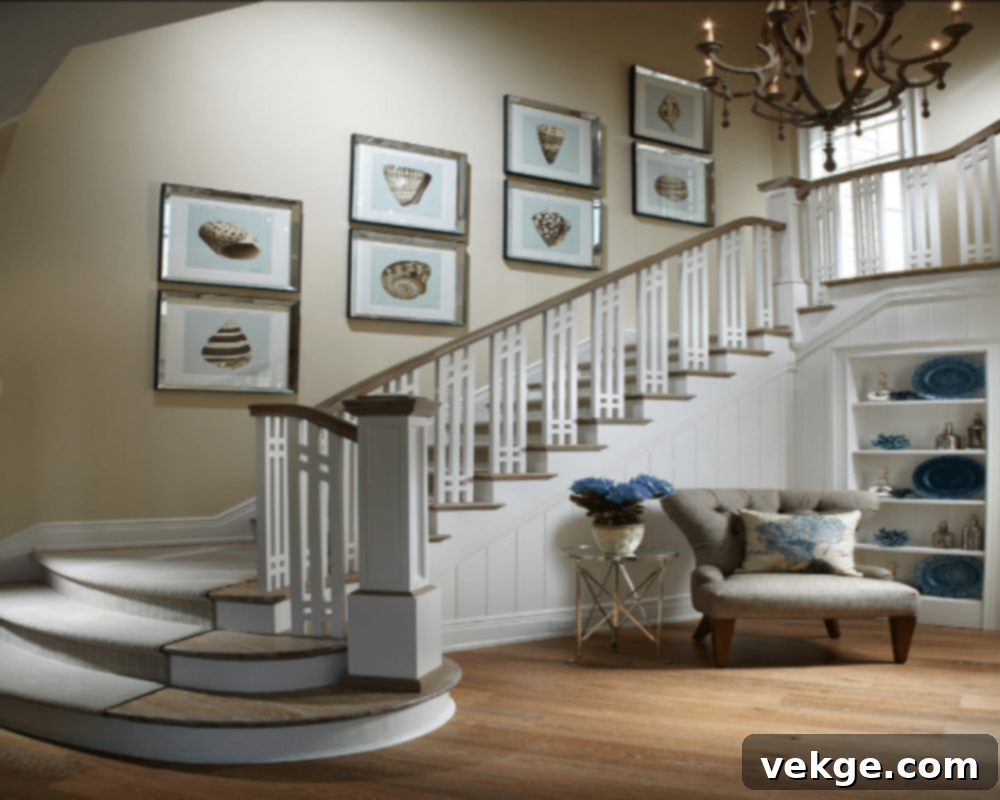
Neutrals like tan, gray, beige, and greige offer a versatile and perpetually flexible staircase color palette, providing a calm and cohesive backdrop for any home style. Their mellow hues blend effortlessly with environments ranging from modern farmhouse and coastal to minimalist and transitional. Light neutrals excel at keeping the staircase feeling airy, spacious, and bright, particularly in areas with limited natural light. Deeper, richer neutral tones, such as charcoal gray or a warm taupe, can add subtle contrast and a touch of sophistication without overpowering the space.
There are countless ways to layer neutrals for visual interest. Consider pairing creamy beige walls with soft gray treads and crisp white risers, or reverse this scheme for a different subtle dynamic. For a truly organic look, integrate natural wood risers with white treads, or combine a greige wall with natural wood banisters. To add definition and a contemporary edge, finish with black metal railings or wrought iron balusters. Layering in natural textures like sisal or jute runners, linen fabrics, and wool throws in adjacent areas can enhance the cozy and inviting appeal of a neutral staircase. The beauty of neutrals lies in their ability to serve as a serene foundation, allowing you to easily update your decor with vibrant accessories or artwork as your style evolves.
6. Vivid Accents for Personality
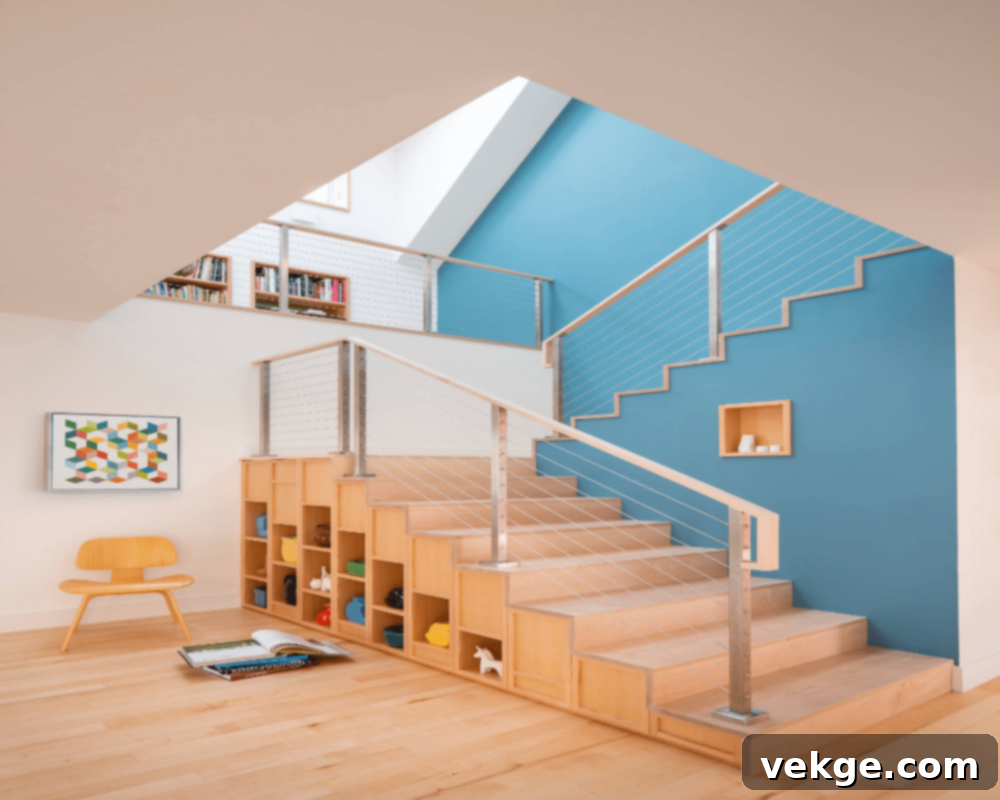
If you’re looking to infuse your home with a burst of individuality and creative flair, incorporating vivid paint colors and accents on select staircase surfaces is an excellent strategy. An unexpected acid green railing, a vibrant azure blue accent wall running alongside the stairs, or even a sunny yellow newel post can immediately draw the eye and make a powerful style statement. Use bold hues like bright yellow, coral, fuchsia, or deep plum to paint just the risers, or highlight specific stair details like the undersides of treads or a decorative baluster.
For a more muted but still distinctive effect, consider earthy accent colors such as rust orange, mustard yellow, or a sophisticated slate blue-green. These shades offer personality without being overtly flashy, blending well with bohemian or eclectic styles. It’s crucial to coordinate these vibrant accent colors with elements in surrounding living spaces, such as throw pillows, artwork, or decorative objects, to ensure a cohesive yet dynamic look. Vivid stair accents are a fantastic way to showcase your bold and creative personality, transforming your staircase into a unique art installation that guests are sure to remember. Consider stenciling patterns on risers for an even more personalized touch, or using removable wallpaper for a temporary burst of color.
7. Metallic Touches for Glamour
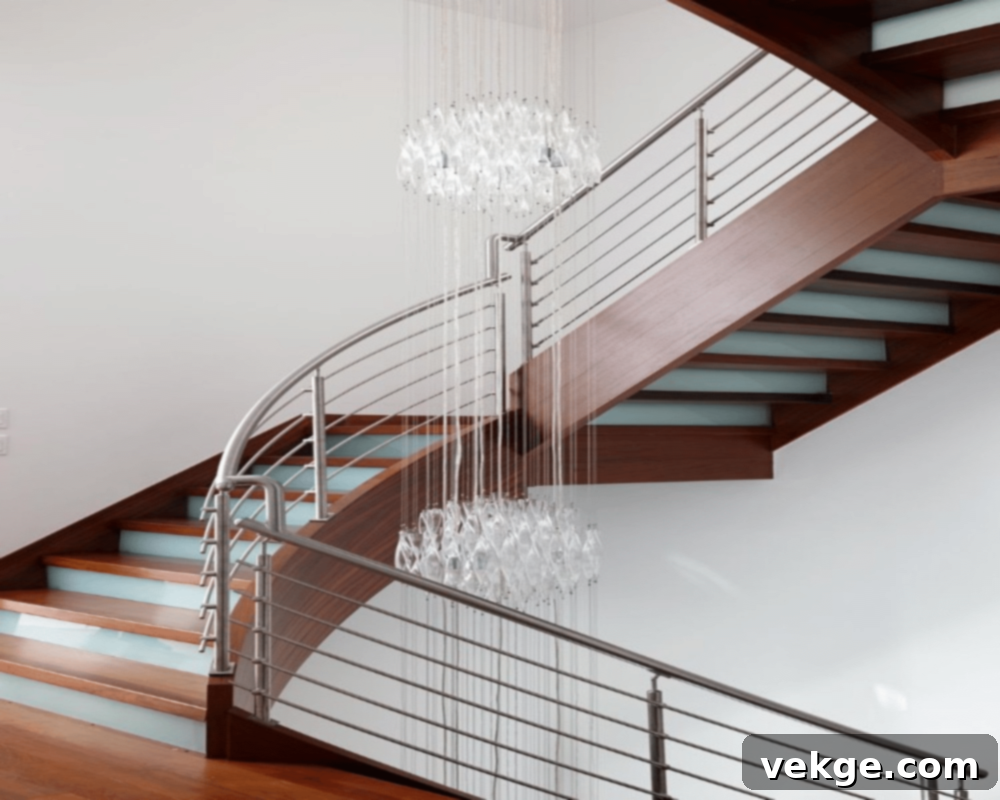
Injecting metallic finishes into your staircase design brings an instant touch of glamour, sophistication, and a reflective sheen that can dramatically elevate the space. Brushed gold, polished silver, warm bronze, or sleek copper paint on railings, balusters, and newel posts can mimic the luxurious look of real metal, adding an expensive feel without the hefty price tag. Pair these gleaming elements with classic black stair treads and light, neutral walls for a striking and elegant contrast that truly shines.
Beyond paint, consider metallic wallpaper on an accent wall adjacent to the staircase or even on the stair risers themselves to add reflective luminosity and an unexpected textural element. For a truly opulent effect, metallic mosaic tiles on stair risers can resemble fine jewelry, catching the light and creating a dazzling display. The key to successfully incorporating metallics is balance: ensure these glitzy elements are offset by neutral walls, understated railings, and simple floors to prevent the space from feeling overwhelmed. This approach allows the metallic touches to be captivating focal points rather than distracting elements. Metallics are perfect for contemporary, modern, art deco, or even luxurious traditional interiors, adding a touch of industrial chic or refined opulence depending on the chosen finish.
The staircase’s color palette is incredibly influential, impacting not only the adjoining rooms but also the overall traffic flow and the ambiance of your entire home. It’s a design decision that requires careful consideration, balancing light and dark, neutral and vivid hues to achieve your desired aesthetic. You can choose to highlight architectural features like elegant railings and open risers with a classic scheme of white walls and steps, creating an expansive and clean look. Alternatively, you can make the stairs themselves the undisputed focal point of your home with bold colors, intricate patterns, or rich textures.
With the right color combinations and a keen eye for detail, your staircase decor can be both safe and stylish, seamlessly matching and enhancing your interior motif. To truly achieve that desired, breathtaking look, take these tips seriously and begin to envision the transformation. A well-designed staircase is more than just a means to an end; it’s one of the most distinguished aspects of a house, deserving of thoughtful decoration. Just like a bride on her wedding day, it should look its absolute best. When guests step into your home, your exquisitely decorated staircase, standing proudly, should be one of the first and most captivating things they notice, leaving a lasting impression of style and elegance.
